In June 2019, Shopify announced its entry into the fulfillment space with a $1 billion investment.
The network took a significant turn in October 2019 when Shopify acquired 6 River Systems, adding warehouse robotics capabilities to its operations.
The COVID-19 pandemic accelerated the network’s growth, with shipping volume increasing 2.5x between Q1 and Q4 2020.
According to the program director’s statement to the Wall Street Journal, this surge pushed the program’s development forward by approximately a decade.
Today, Shopify Fulfillment Network (SFN) operates through a partnership with Flexport, handling inventory storage and order fulfillment across multiple warehouses in North America.
When a customer places an order, the system picks, packs, and ships products from the nearest fulfillment center, typically delivering within three days in the US.
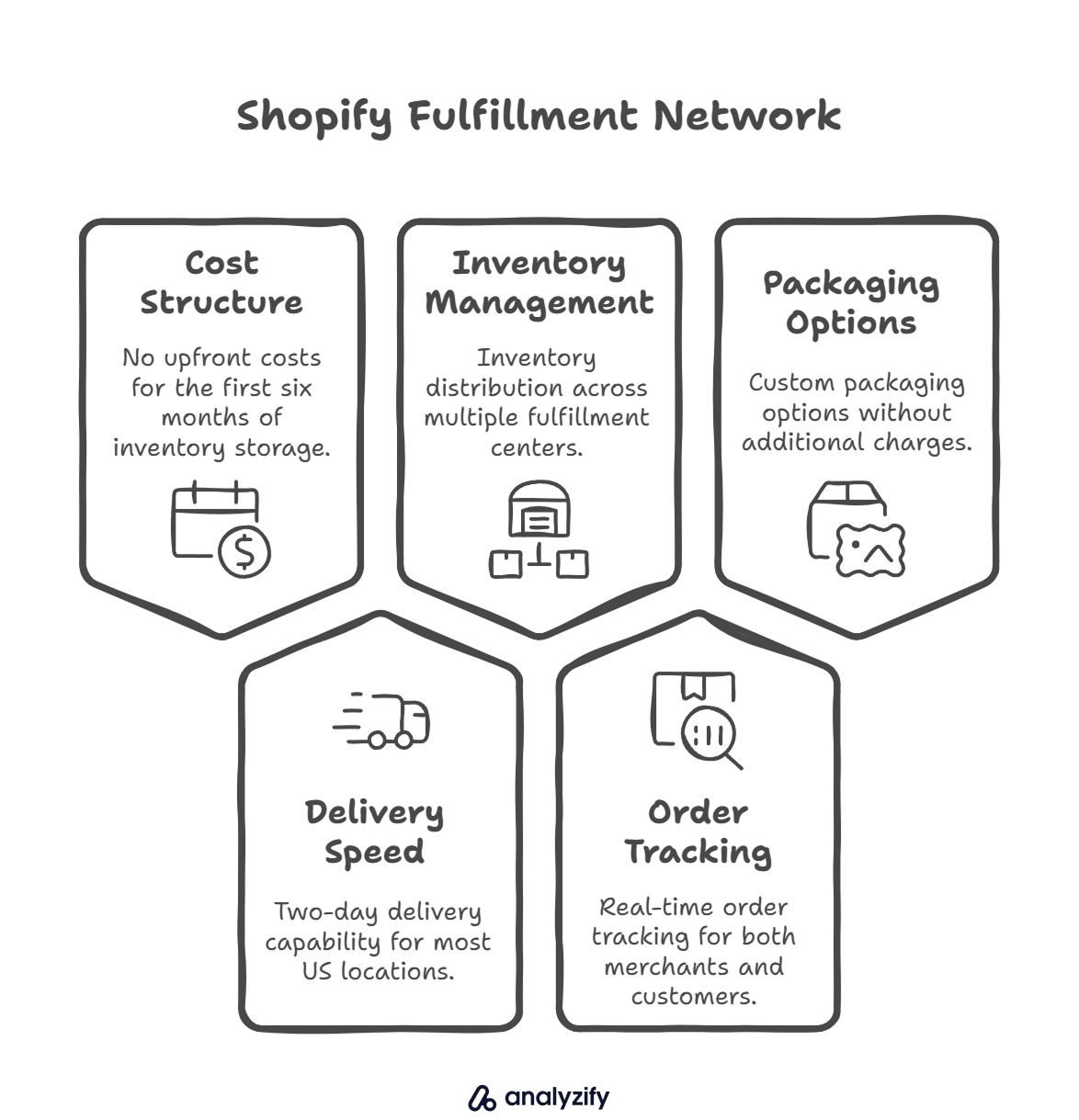
Key features of Shopify Fulfillment Network:
- No upfront costs for the first six months of inventory storage
- Two-day delivery capability for most US locations
- Inventory distribution across multiple fulfillment centers
- Real-time order tracking for both merchants and customers
- Custom packaging options without additional charges
Shopify Fulfillment Network’s accuracy rate stands at 99.5%, achieved through automated systems in fulfillment centers.
This automation allows merchants to maintain product availability across different sales channels while keeping inventory synchronized through their Shopify admin panel.
For merchants considering SFN, it’s worth noting that the network currently operates exclusively in the US and Canada, with nine fulfillment centers strategically placed for optimal distribution.
The system allows merchants to send inventory to a single location, from which Flexport handles the distribution across their network based on demand patterns and delivery zones.
How Much Does Shopify Fulfillment Network Cost in 2025?
SFN operates on a pay-as-you-sell model, where costs are tied directly to your sales rather than requiring large upfront investments. The fee structure includes both daily and monthly charges.
Daily Charges:
- Fulfillment fees (approximately $7.76 per unit for an 8oz item)
- International fulfillment fees
- Return processing fees
- Non-compliant shipment penalties

These daily fees cover the essential operations of picking, packing, and shipping to customers. The exact amount varies based on product specifications and shipping destinations.
Monthly charges include storage and special handling:
- Storage fees: $2.25 per cubic foot (after 180 days)
- Special project handling for custom requirements
- Barcode relabeling when needed
- Program fee: $29
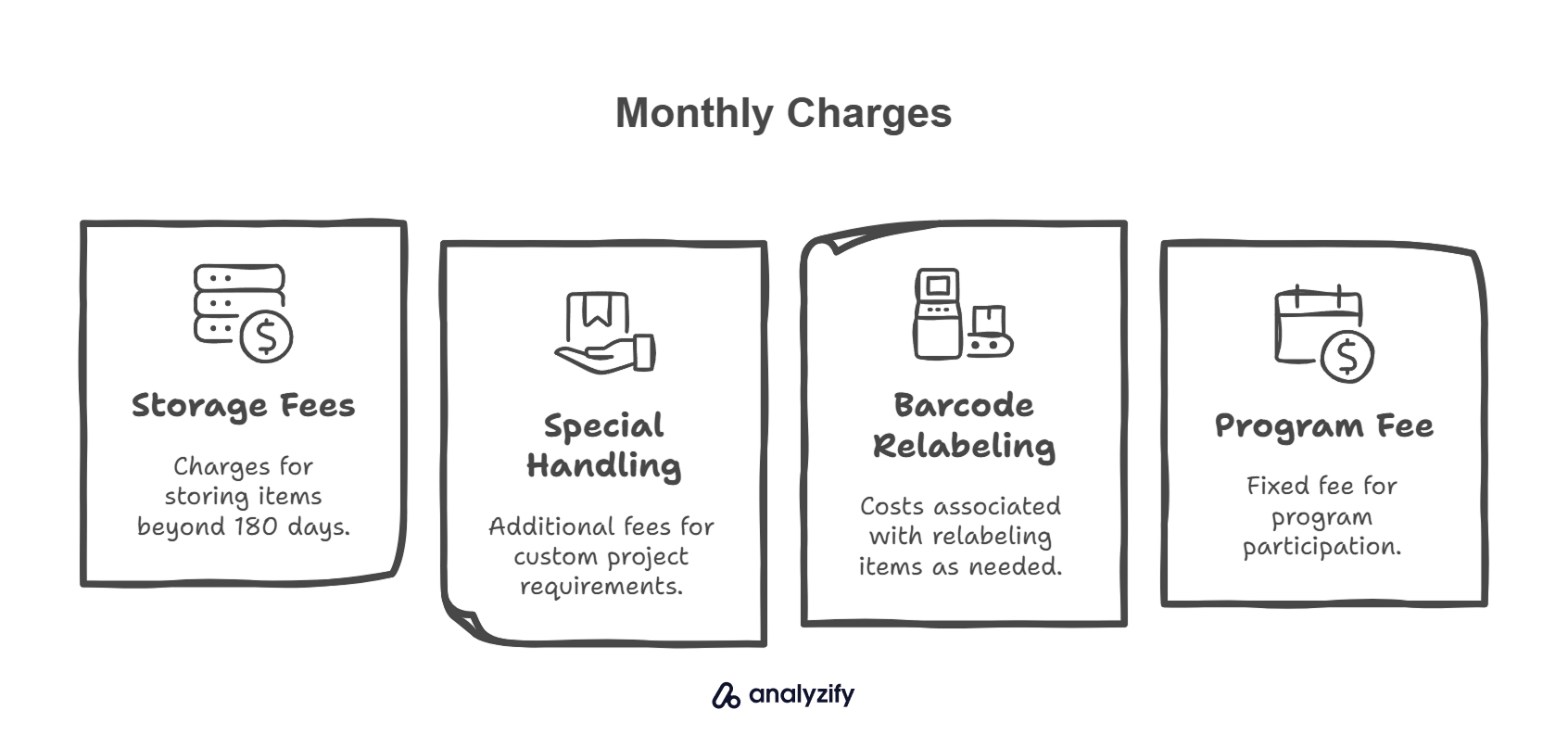
To understand the real impact on your business, here’s a practical example of a merchant shipping 200 units monthly. With a revenue of $4,000, they pay $1,552 in fulfillment fees and $29 in program fees.
If their inventory turns over within 180 days, they avoid storage fees entirely, leaving them with $2,419 before product costs.
Hidden costs that might affect your bottom line:
- Non-compliant inbound receiving fees
- Product relabeling charges
- Custom packaging requirements
- Return processing expenses
SFN provides a calculator for accurate cost estimation. By inputting your product details and expected volume, you can plan your expenses effectively.
The key to managing costs lies in maintaining efficient inventory turnover to maximize the benefit of the 180-day free storage period.
Who Can Use Shopify Fulfillment Network?
Shopify Fulfillment Network operates under strict eligibility rules that directly impact whether you can use their services.
Primary eligibility requirements for Shopify Fulfillment Network:
- Business location in the US or Canada
- Minimum of 1 order per day
- Active Shopify Payments account
- Under 2,000 unique SKUs
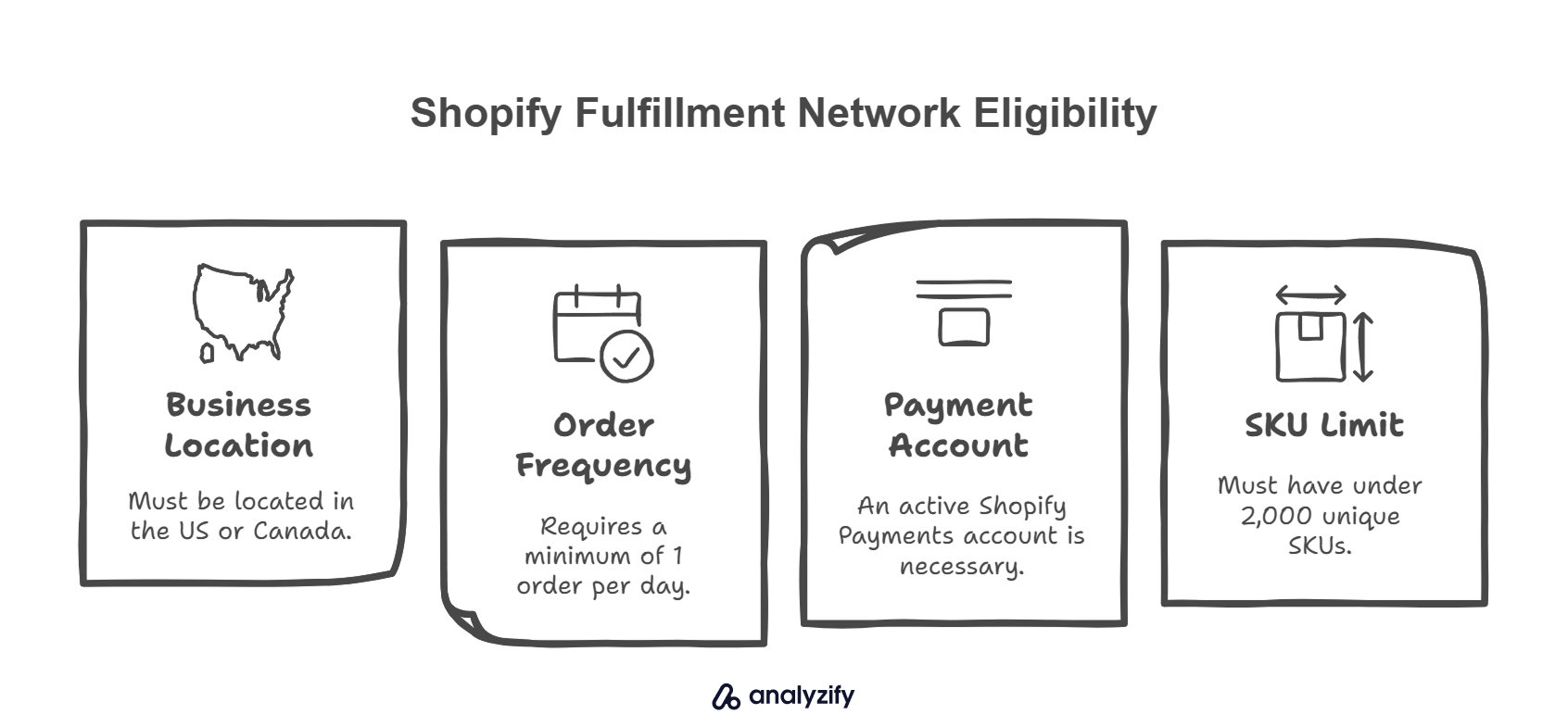
Shopify Fulfillment Network currently serves North American businesses only. This means both your business base and main customer locations must be in the United States or Canada.
Product restrictions apply to certain categories:
- Hazardous materials
- Perishable items
- High-value goods requiring special handling
- Products with specific temperature requirements
- Items requiring special licenses or permits
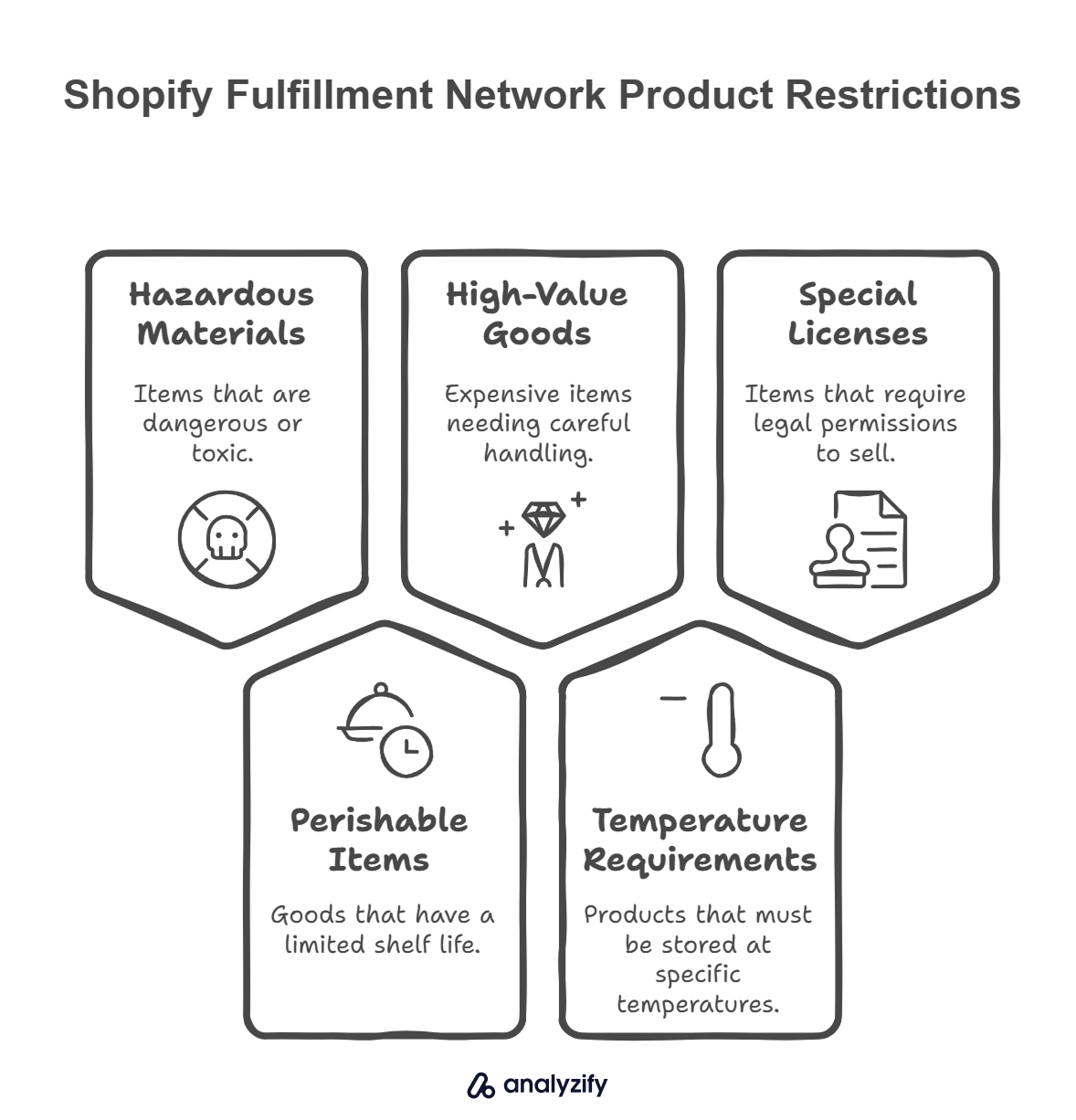
Daily order volume shapes your success with Shopify Fulfillment Network. The minimum is one order per day, but businesses shipping 10 to 2,000 orders daily see the best results from their distribution system and cost structure.
Storage limitations to consider:
- Maximum of 2,000 distinct products
- Products must fit standard shipping requirements
- Items must include proper barcoding
- All products require clear identification and documentation

Through Flexport, you can sell on multiple platforms like Amazon, Walmart, and eBay while keeping fulfillment in one place. However, your products must meet size and weight limits, include correct documentation, and follow shipping rules to avoid extra fees or rejection.
How Does Shopify Fulfillment Network Actually Work?
Shopify Fulfillment Network runs through a four-step process that starts when you ship your inventory and ends with customer delivery.
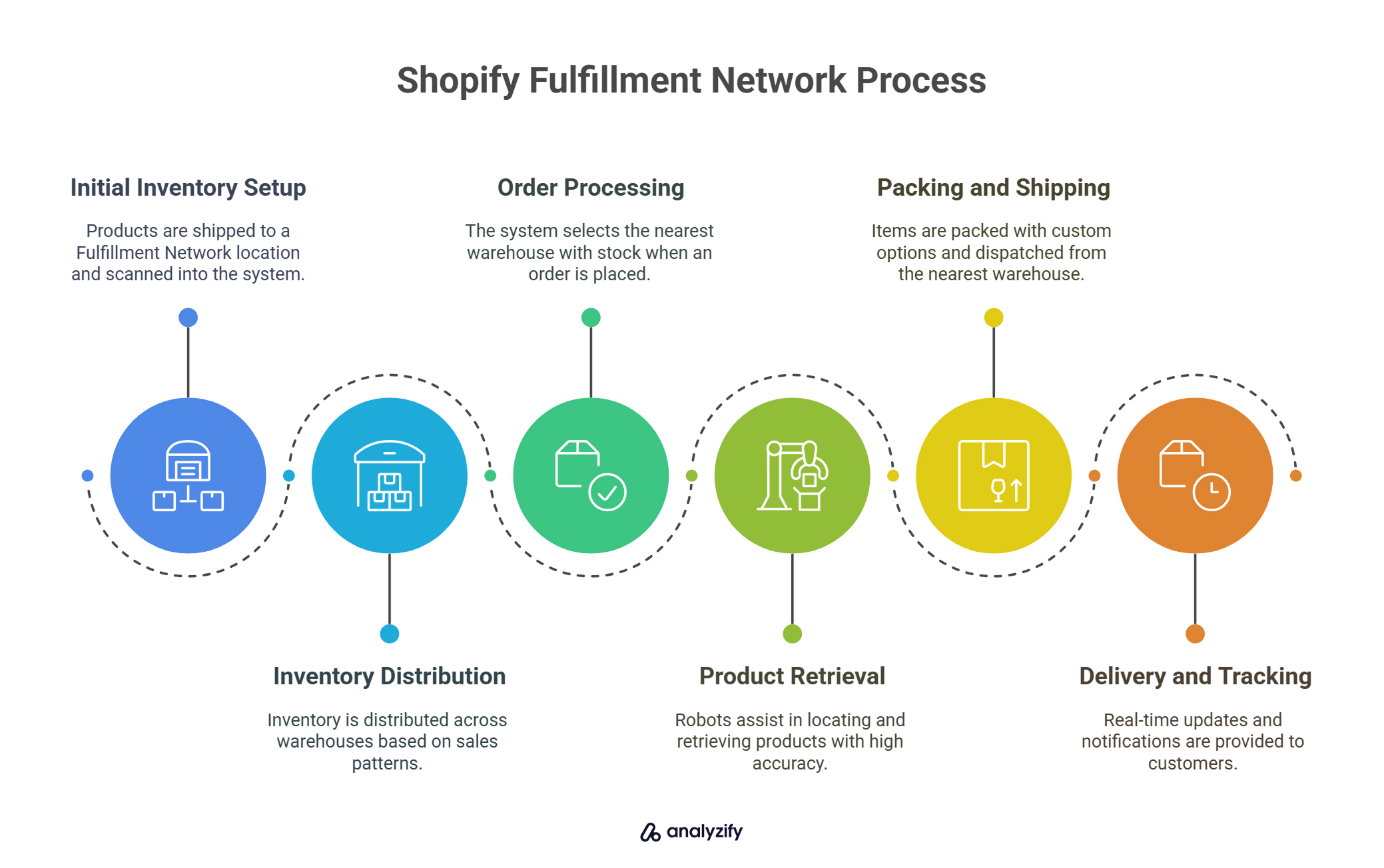
Step 1: Initial Inventory Setup
- Ship your products to a single Shopify Fulfillment Network location
- Flexport scans and records each item into their system
- Your inventory gets distributed across their warehouse network based on your sales patterns
The warehouse network spans multiple locations across North America, and Flexport uses data analysis to predict demand patterns. This means your products get stored closer to where your customers typically order from, cutting delivery times and shipping costs.
Step 2: Order Processing
Order Processing begins when a customer places an order on your store. The system automatically selects the nearest warehouse with available stock, and robots assist in locating and retrieving products with 99.5% accuracy.
Step 3: Packing and Shipping includes:
- Items packed according to your specifications
- Free custom packaging options
- Automatic shipping label generation
- Dispatch from the closest warehouse to delivery address
The entire process syncs with your Shopify admin panel, where you track real-time inventory levels and view order status updates. Most US deliveries reach customers within 2-3 days.
Step 4: Delivery and tracking provide:
- Real-time status updates in your admin
- Automated customer shipping notifications
- Streamlined return processing
- Inventory movement visibility
Special handling options extend beyond basic fulfillment. You can request custom packaging designs, create product bundles, process returns, and reallocate inventory between warehouses as needed.
Through your admin panel, you maintain constant visibility of your operation’s performance, from inventory levels to delivery timeframes and return requests.
What Are the Real Limitations of Shopify Fulfillment Network?
Several key limitations affect merchants using Shopify Fulfillment Network, particularly in their daily operations and growth plans.
Shipping carrier restrictions pose a significant challenge. Even if you’ve negotiated better rates with carriers independently, you must use Shopify Fulfillment Network’s pre-negotiated rates. This often impacts merchants who have built strong relationships with specific carriers.
Package customization limits include:
- No marketing material insertion during packing
- Fixed packaging material options
- Restricted bundle creation flexibility
- Limited special handling capabilities
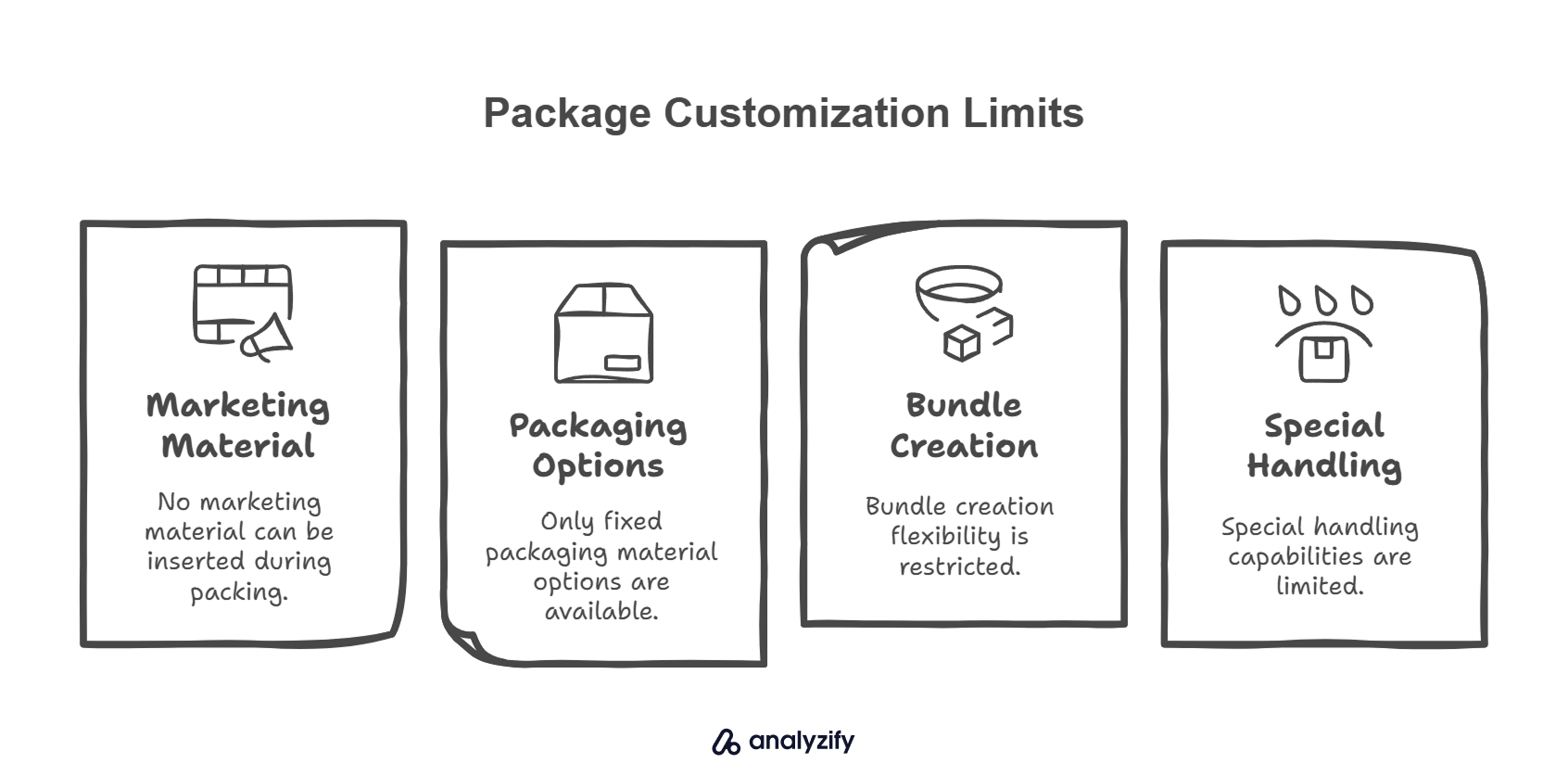
The fulfillment process comes with rigid requirements that affect operational flexibility. Merchants can’t choose specific warehouses for their inventory, as Flexport’s system automatically determines product distribution across their network.
System constraints that impact scaling:
- No ability to modify shipping carrier selection
- Fixed processing schedules
- Limited rush order capabilities
- Restricted batch processing options

The return process presents its own challenges. While Shopify Fulfillment Network handles returns, merchants have minimal control over:
- Return processing priorities
- Inspection criteria
- Restock timing
- Inventory redistribution after returns
These limitations particularly affect seasonal businesses and those with rapid inventory turnover. The fixed structure of the fulfillment system means merchants must adapt their operations to fit within these constraints rather than the other way around.
Is Shopify Fulfillment Network Worth It? (Based on Business Size)
Your order volume significantly impacts the value you’ll get from Shopify Fulfillment Network. Here’s how it works for different business sizes.
Small Business (10-50 orders/day):
- Fulfillment fees take a larger percentage of revenue
- Storage fees rarely apply due to faster inventory turnover
- Shipping speed improvements may not offset costs
- Manual fulfillment might be more cost-effective
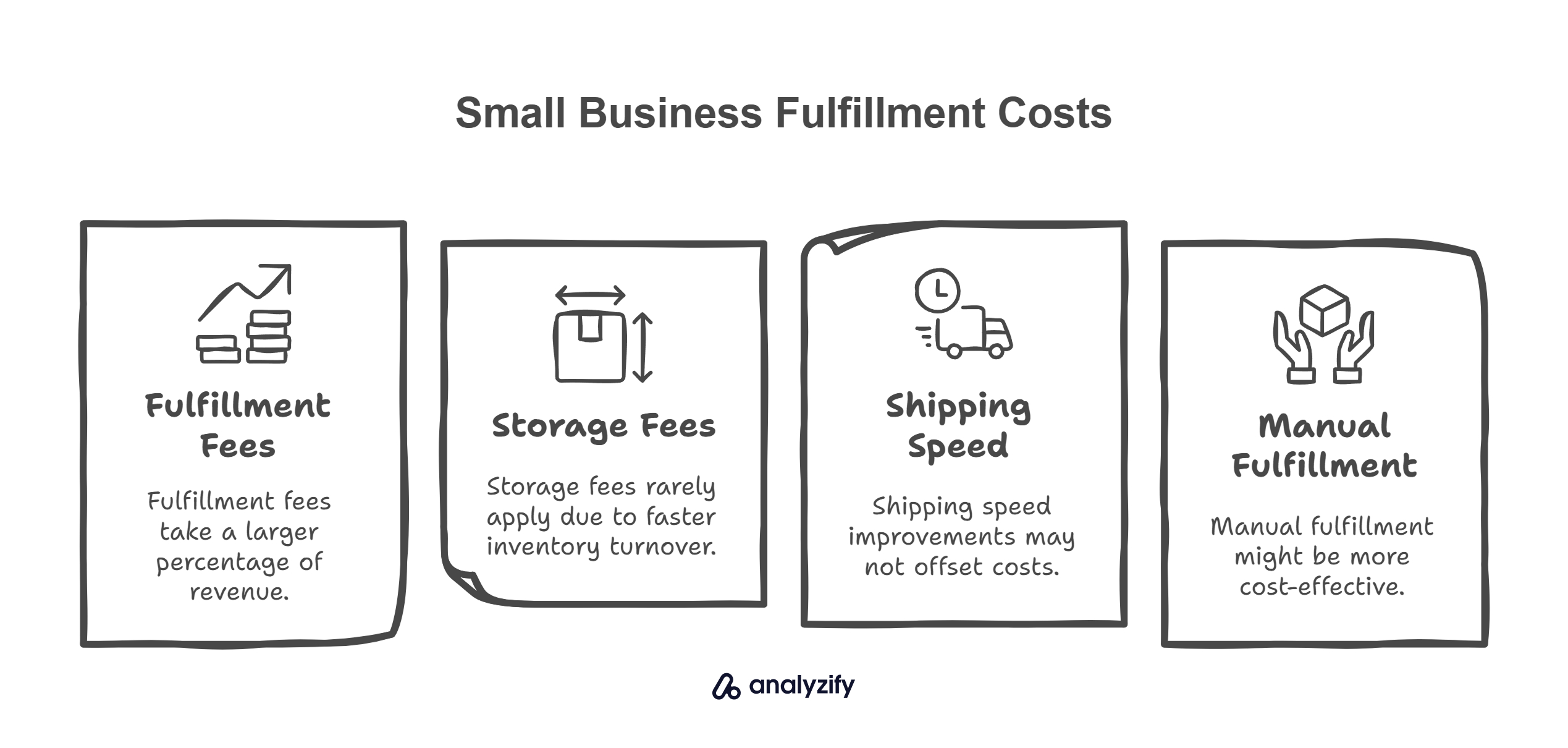
For small businesses, the math often doesn’t work in favor of using Shopify Fulfillment Network. A business shipping 10 orders daily spends about $77.60 on fulfillment fees, plus the $29 monthly program fee. With $200 in daily revenue, these fees consume nearly 40% of income before product costs.
Medium Business (51-200 orders/day):
- Cost per order decreases with volume
- Storage fees become manageable with steady sales
- Two-day delivery capability increases conversion rates
- Time saved justifies the investment
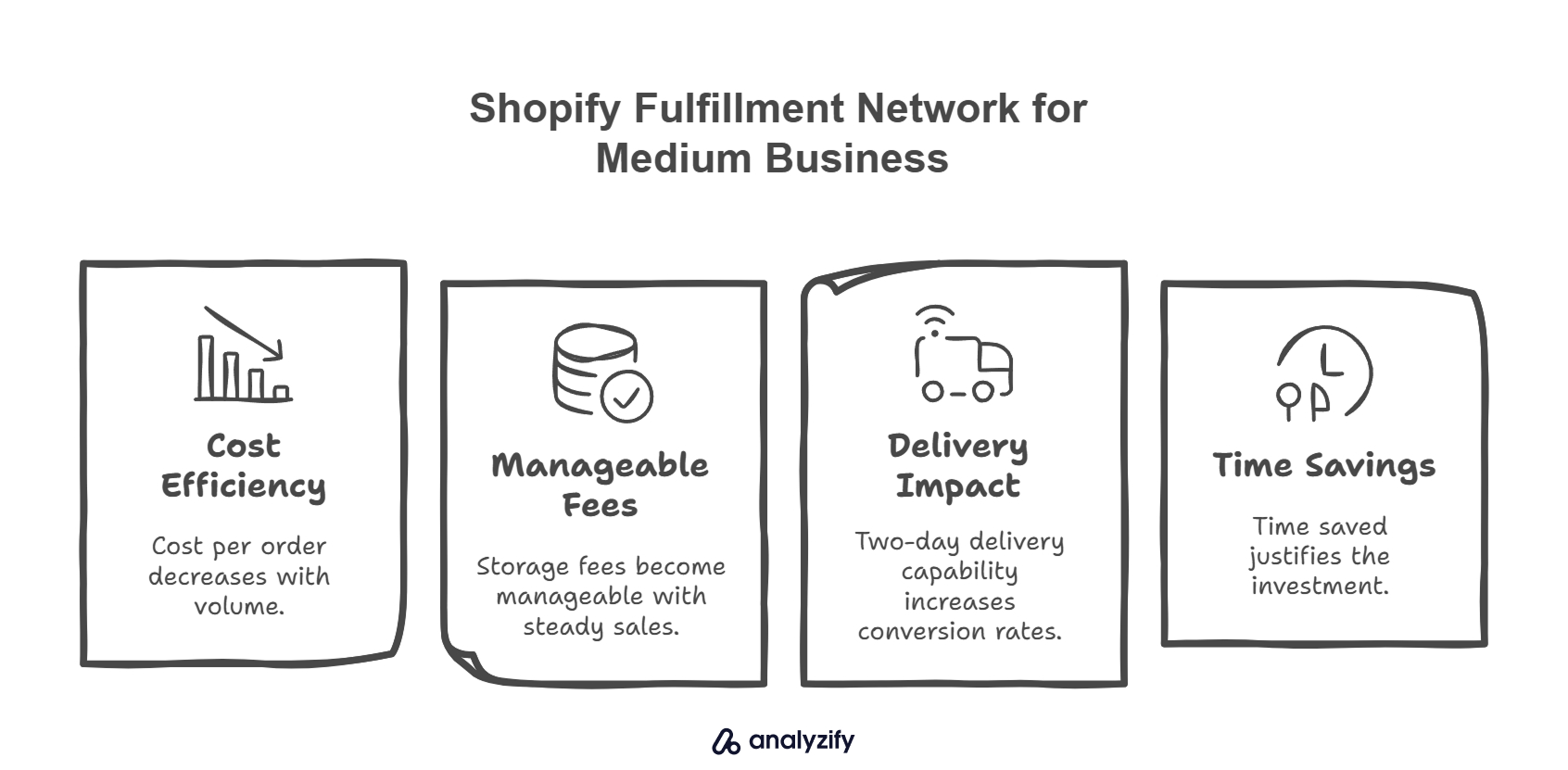
At this volume, Shopify Fulfillment Network starts showing its value. A business processing 200 orders monthly generating $4,000 in revenue pays about $1,581 in total fees. This leaves $2,419 for other business expenses, making the service more financially viable.
Large Business (201+ orders/day):
- Multi-location inventory distribution becomes valuable
- Automated fulfillment reduces operational complexity
- Return processing saves significant staff time
- Consistent delivery times support business growth

Larger operations benefit from reduced per-order costs and the network’s ability to handle complex fulfillment needs. The automation and distribution capabilities become particularly valuable when managing high daily order volumes.
Real revenue impact varies by business type:
- Fashion retailers see 15-20% fewer cart abandonments
- Tech products benefit from faster delivery expectations
- Food and beverage items need careful volume planning
- Seasonal items require strategic storage management
The decision ultimately depends on your margins and operational costs. Calculate your current fulfillment expenses, including staff time, shipping costs, and storage fees, before comparing them to Shopify Fulfillment Network’s pricing structure.
Shopify Fulfillment Network vs Amazon FBA: A Cost Comparison
Choosing between these two major fulfillment services requires looking beyond simple fee structures. Each service charges fees differently, affecting your profit margins in distinct ways.
Basic fee breakdown for Amazon FBA:
- $40 monthly program fee plus category-based referral fees ranging from 8-17% of product price
- Per-item fulfillment fees that vary by product size and weight
- Storage fees that change seasonally, increasing significantly during holidays
- Additional charges for return processing and special handling
Shopify Fulfillment Network structures its fees more simply. They charge a $29 monthly program fee, with fulfillment costs based primarily on weight. Storage remains free for the first 180 days, making it particularly attractive for products with steady sales.
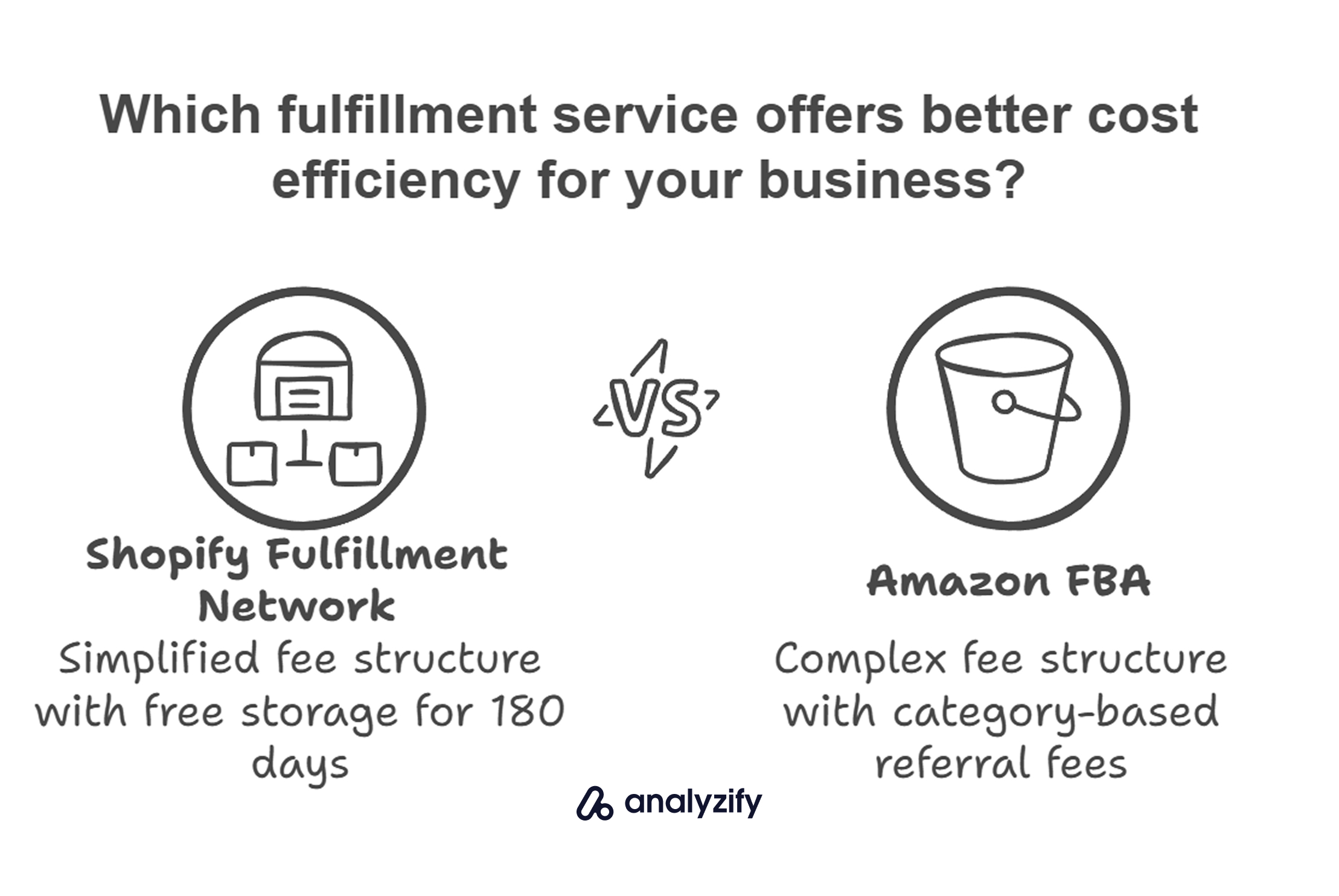
Let’s examine a real example using a $20 product weighing under one pound, selling 200 units monthly. Through Amazon FBA, you’ll pay $1,274 in total fees, broken down into $40 for the program, $600 in category fees, $584 in fulfillment, and $50 for storage.
The same volume through Shopify Fulfillment Network costs $1,581, consisting of a $29 program fee and $1,552 in fulfillment charges.
Critical differences that affect your choice:
- Brand control and visibility on your own platform versus Amazon’s marketplace
- Competition levels and pricing pressure
- Customer data access and marketing capabilities
- Flexibility in product presentation and bundling
While Amazon FBA shows lower costs at higher volumes, merchants often face intense price competition on their platform. This price pressure can quickly eliminate the cost advantage. Shopify Fulfillment Network, though slightly more expensive, provides greater control over your brand and customer relationships.
The final choice depends on your specific needs:
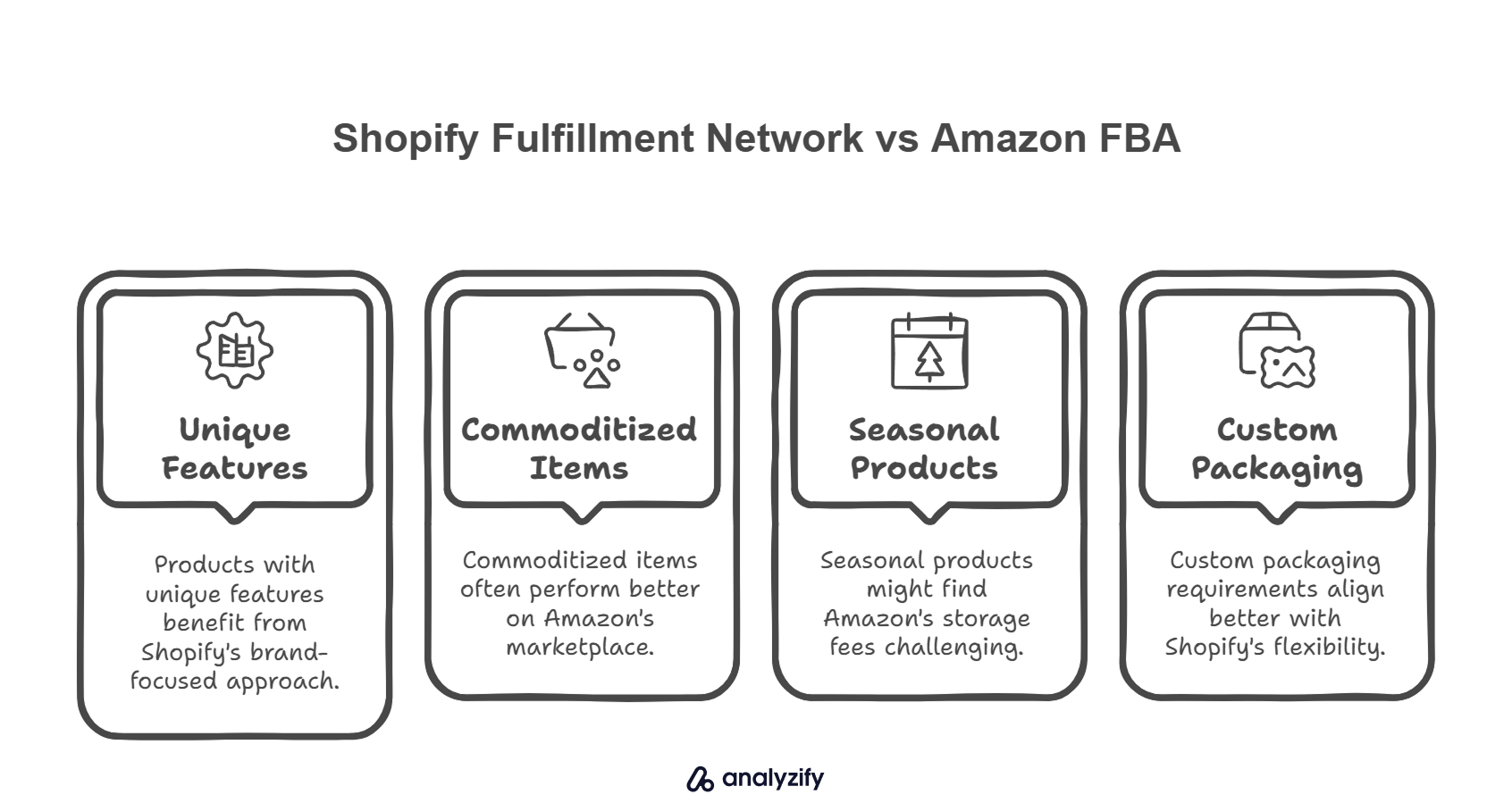
- Products with unique features benefit from Shopify’s brand-focused approach
- Commoditized items often perform better on Amazon’s marketplace
- Seasonal products might find Amazon’s storage fees challenging
- Custom packaging requirements align better with Shopify’s flexibility
Your decision should prioritize long-term growth potential over short-term cost savings. Consider how each platform’s ecosystem aligns with your business model and customer experience goals.
Shopify Fulfillment Network Alternatives
Shopify Fulfillment Network (SFN) simplifies order fulfillment for Shopify merchants, but it has clear limitations. It only operates in the U.S. and Canada, has fixed carrier rates, and enforces strict inventory requirements. For businesses needing more flexibility, lower costs, or international reach, third-party fulfillment services provide alternative solutions.
Bonus: If you’re considering fulfillment options beyond Shopify Fulfillment Network, our guide on the ” Best Fulfillment Companies for Small Businesses” covers top alternatives, their advantages, and key factors to help you choose the right fit.
1. ShipNetwork
ShipNetwork operates multiple fulfillment centers across the U.S., aiming to reduce shipping times and costs by distributing inventory efficiently.
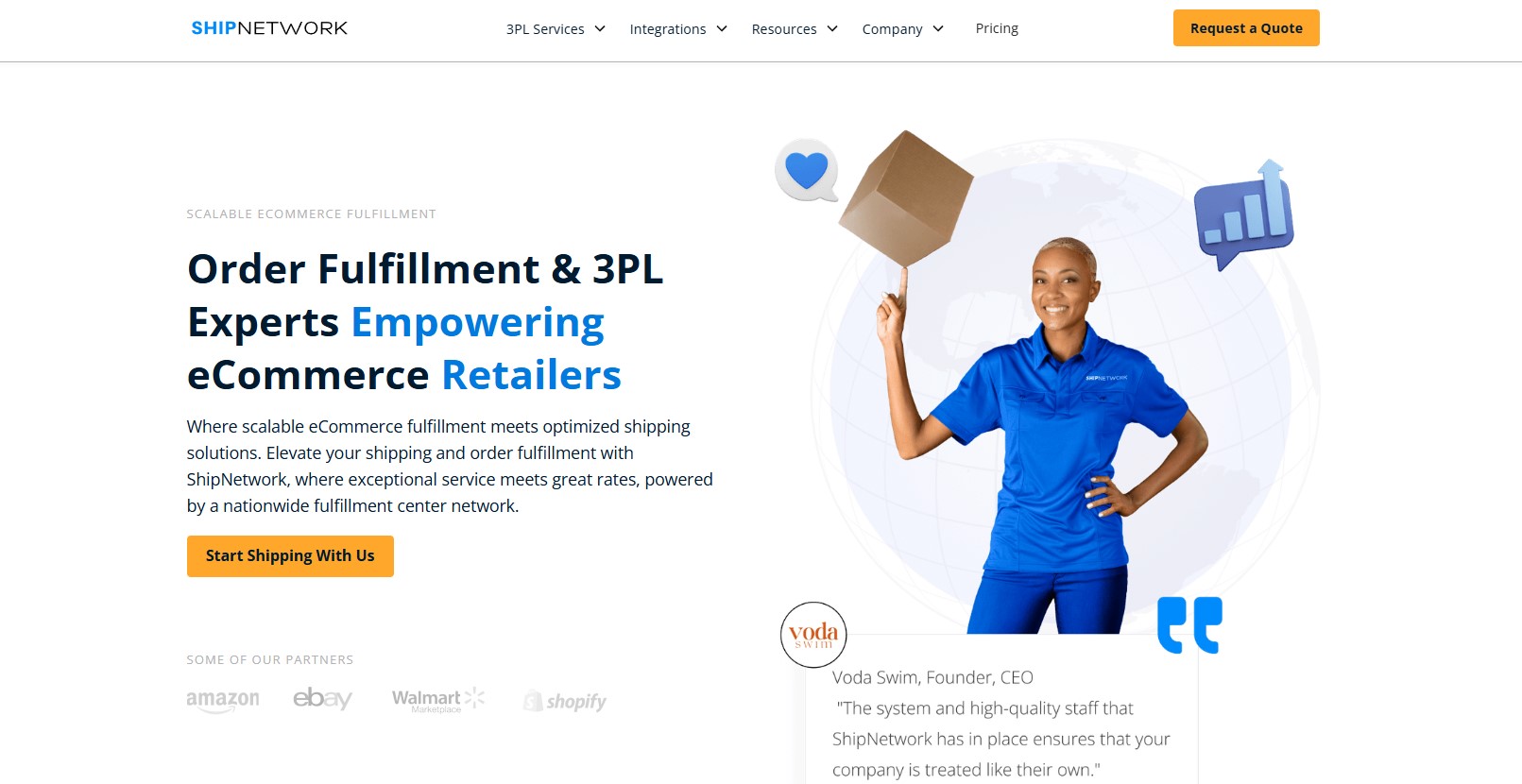
Advantages:
- 100% order accuracy guarantee, minimizing mispicks and delays.
- Return management services to handle customer returns efficiently.
- Distributed fulfillment network for faster deliveries and lower shipping rates.
- Custom fulfillment options, including subscription box services.
Drawbacks:
- Limited international reach—best suited for businesses selling primarily in the U.S.
- Pricing varies based on shipping volume, making cost prediction difficult.
- Heavily reliant on carrier partnerships, which may not always offer the lowest rates.
2. ShipBob
ShipBob has fulfillment centers in the U.S., Canada, and Europe, making it a strong option for businesses selling in multiple regions. It integrates directly with Shopify and other platforms, providing real-time inventory and order tracking.

Advantages:
- Expedited shipping options, with two-day delivery available in many areas.
- Custom packaging and kitting options for brands wanting more control over presentation.
- No minimum order volume, making it accessible to small and mid-sized businesses.
Drawbacks:
- Monthly storage fees can add up, particularly for slow-moving inventory.
- Setup and onboarding take time, which may delay fulfillment improvements.
- Customer support can be inconsistent, especially during peak seasons.
3. Fulfillment by Amazon (FBA)
Amazon FBA allows merchants to store inventory in Amazon’s warehouses, with Amazon handling packing, shipping, and customer service. While it provides access to Prime members and fast shipping, it comes with strict policies and costs.
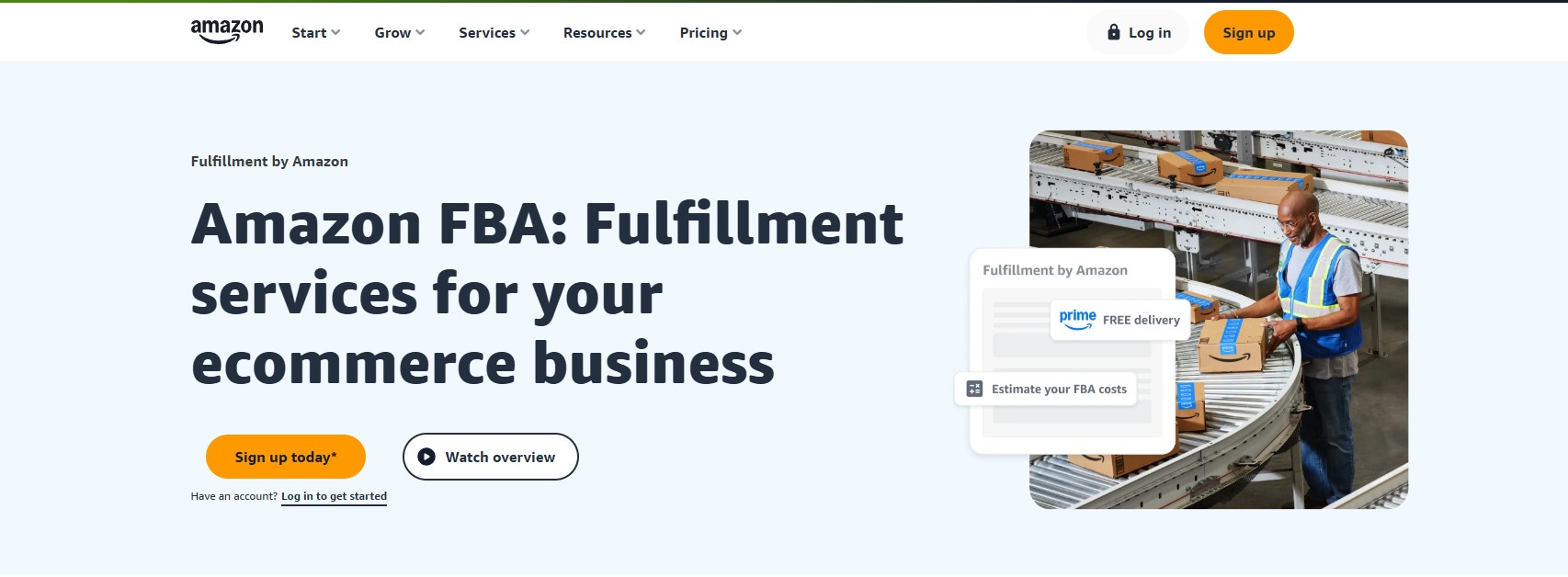
Advantages:
- Fast and reliable shipping through Amazon’s logistics network.
- Prime eligibility can boost sales by increasing product visibility.
- Hands-off fulfillment, freeing merchants from logistics management.
Drawbacks:
- High storage fees, especially for slow-moving or seasonal products.
- Limited control over branding—Amazon packaging is used instead of custom packaging.
- Strict inventory compliance rules that may lead to unexpected fees or stock rejections.
4. Red Stag Fulfillment
Red Stag specializes in bulky, heavy, and high-value products, making it a good option for merchants selling items that don’t fit standard fulfillment models.

Advantages:
- Same-day fulfillment for orders placed before the cutoff time.
- High inventory accuracy, reducing shipping mistakes and stock discrepancies.
- Custom handling options for fragile or oversized products.
Drawbacks:
- Higher costs compared to standard fulfillment services.
- Limited global reach—best for businesses shipping within the U.S.
- Not ideal for businesses with small, lightweight, or fast-moving consumer goods.
5. ShipMonk
ShipMonk operates fulfillment centers in the U.S., Canada, Mexico, and Europe, providing storage and shipping solutions across multiple regions. It supports a variety of product types, including restricted categories like CBD and supplements.
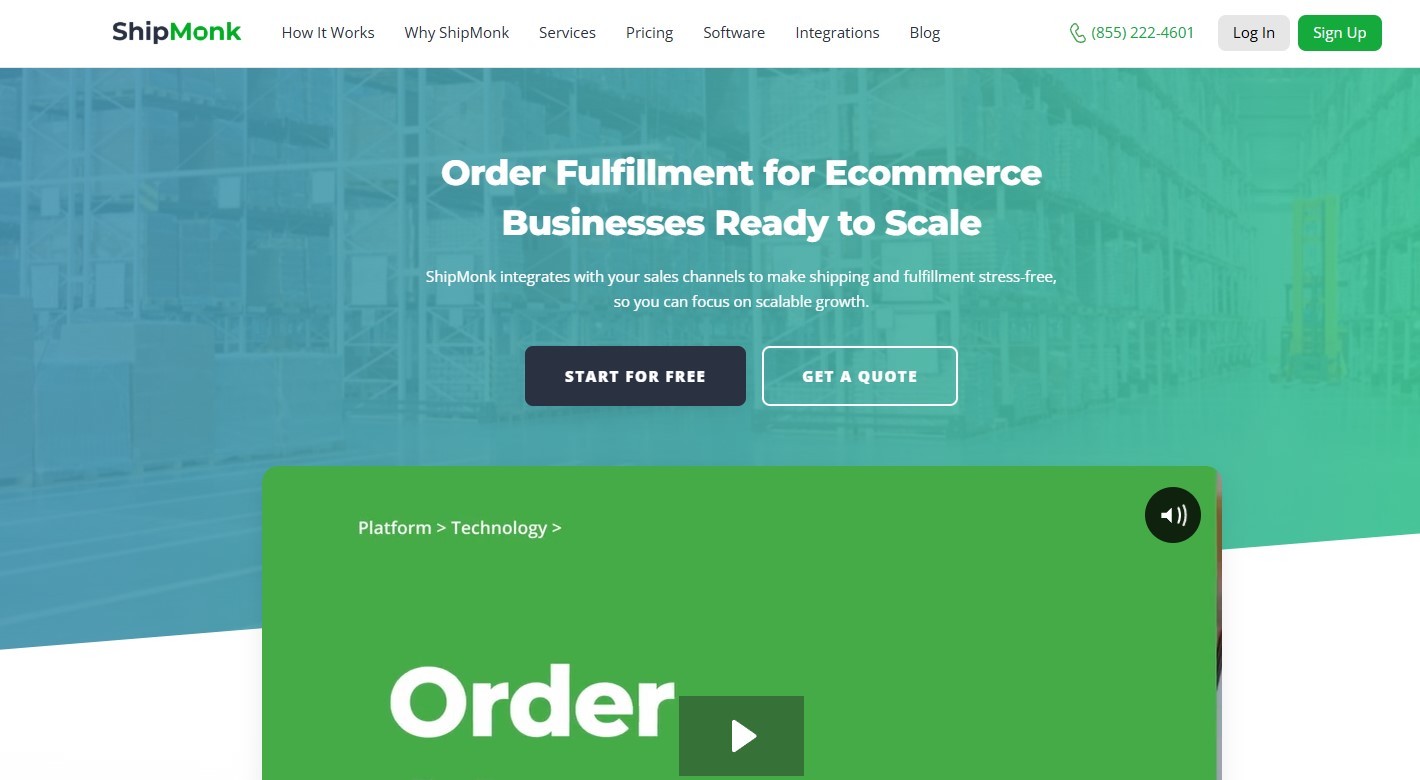
Advantages:
- Wide warehouse network allows for distributed inventory storage.
- Transparent pricing structure with detailed cost breakdowns.
- Supports multiple sales channels, including marketplaces like eBay and Walmart.
Drawbacks:
- Processing times can be slower than expected during peak seasons.
- Complex pricing model can make cost estimation difficult.
- Customer support response times vary, which can be frustrating for urgent issues.
Bonus: For a broader look at fulfillment services across the country, check out our ” Explore the Best Fulfillment Companies in the US” guide. It breaks down industry leaders, regional options, and cost-effective solutions tailored to different business models.
Choosing the Right Alternative
Each fulfillment service has strengths and weaknesses. Shopify Fulfillment Network is well-suited for merchants who prioritize Shopify integration and don’t need international shipping. ShipBob and ShipNetwork provide broader reach, but storage fees and onboarding complexity may be drawbacks.
FBA offers unmatched shipping speed but limits branding control. Red Stag is best for oversized products, while ShipMonk is a strong choice for businesses with diverse inventory needs.
The right choice depends on factors like order volume, storage costs, delivery speed, and branding priorities. A careful cost-benefit analysis will help determine which provider aligns best with your business goals.
Final Words
Your product type, sales volume, and business goals matter more than raw cost numbers when picking a fulfillment service. If you sell unique products, want direct customer relationships, and value brand control, Shopify Fulfillment Network might fit your needs.
Just make sure your daily order volume can justify the fees, and you’ve planned your inventory turnover to take advantage of the 180-day free storage.
Shopify Fulfillment Network: FAQ
Here are the most searched questions about Shopify Fulfillment Network, answered based on current data and merchant experiences.
Is Shopify Fulfillment Network only for Shopify stores?
No. While you need a Shopify account, you can fulfill orders from multiple sales channels including Amazon, eBay, and Walmart through Flexport’s integration capabilities.
How long does Shopify Fulfillment Network take to deliver?
Most US deliveries arrive within 2-3 days. This timeframe applies to domestic shipments, with international delivery times varying based on destination country.
What happens if my products don’t sell within 180 days?
After 180 days, you’ll be charged $2.25 per cubic foot monthly for stored inventory. Consider your product turnover rate carefully to avoid these long-term storage fees.
Can I use my own shipping carriers with Shopify Fulfillment Network?
No. You must use Shopify Fulfillment Network’s pre-negotiated rates and carriers, even if you have better rates with other carriers.
What happens if Shopify Fulfillment Network loses my inventory?
Shopify Fulfillment Network maintains detailed inventory tracking with 99.5% accuracy. In rare cases of loss, they have a claims process for inventory reimbursement.
Can I ship hazardous materials through Shopify Fulfillment Network?
No. Hazardous materials, perishables, and items requiring special permits or temperature control cannot be fulfilled through the network.

































